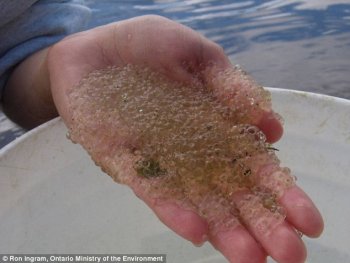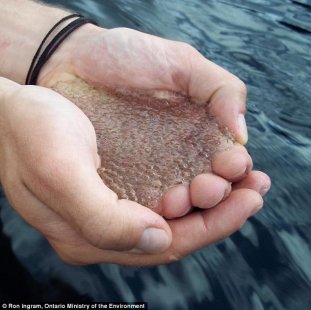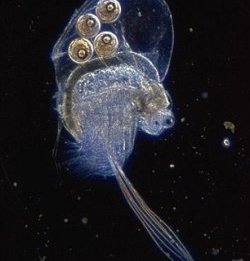
 'Jellification': A researcher holds up a scoop of the jello-like scum produced by a type of plankton which has multiplied rapidly thanks to industrial processes
'Jellification': A researcher holds up a scoop of the jello-like scum produced by a type of plankton which has multiplied rapidly thanks to industrial processes
After-effects: A decline in calcium, caused by effects like acid rain, killed off competitors and allowed the scum-producing Holopedium gibberum to expand
Researchers - who pictured themselves scooping gelatinous handfuls of the scum out of the lakes - said they found calcium levels in the earth by the lakes had plummeted in recent decades.
Chemical waste from factories - spread by weather phenomena like acid rain - can eat away at minerals usually present in soil, causing profound changes to the animals and plants that live nearby.
According to the researchers - a mixture of government scientists and academics from the universities of Cambridge and Ottawa - populations of the plankton which produce the substance has doubled since the 1980s.
 It has corresponded with a decline in the calcium levels in surrounding soil, which began with the rise of industry in the 1850s, but picked up significantly in the late 20th Century.
It has corresponded with a decline in the calcium levels in surrounding soil, which began with the rise of industry in the 1850s, but picked up significantly in the late 20th Century.
Once-pristine: The jello-like layer is covering lakes in Canada. Pictured is a body of water in Muskoka
The lakes used to be full of a different species of plankton - called Daphnia - which had lived there for centuries and thrived on the calcium which made its way into the water from surrounding soil.
The tiny animal needed the calcium to build a thick exo-skeleton that stopped it from getting eaten by midges - but when the deposits started to run out they struggled to survive.
While populations declined, the Holopedium gibberum - which doesn't need as much calcium - began to thrive instead.
Their defensive mechanism is to surround themselves with a jello-like scum, which is now spreading over the lake.
Invader: The Holopedium gibberum is producing the 'jelly' substance as a defense against predators
As well as contributing to the 'jellification' effect, falling calcium levels could have a knock-on effect on public health, as these nutrients can make their way up the food chain into humans. The water could also become less safe to use.


YOU MIGHT ALSO LIKE












